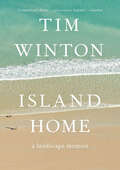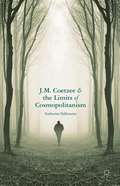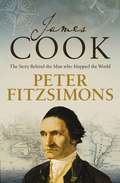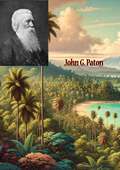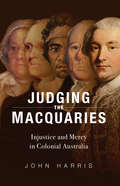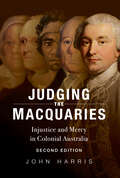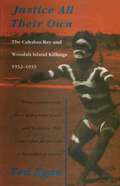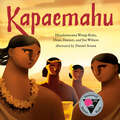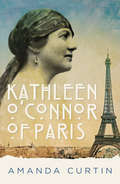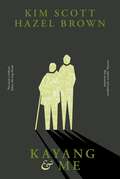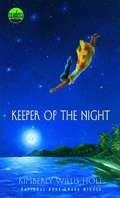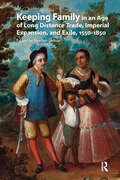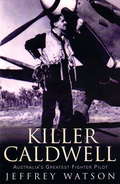- Table View
- List View
Island Home: A Landscape Memoir
by Tim WintonThe writer explores his beloved Australia in a memoir that is “a delight to read [and] a call to arms . . . It beseeches us to revere the land that sustains us” (Guardian).From boyhood, Tim Winton’s relationship with the world around him?rock pools, sea caves, scrub, and swamp?has been as vital as any other connection. Camping in hidden inlets, walking in high rocky desert, diving in reefs, bobbing in the sea between surfing sets, Winton has felt the place seep into him, and learned to see landscape as a living process. In Island Home, Winton brings this landscape?and its influence on the island nation’s identity and art?vividly to life through personal accounts and environmental history.Wise, rhapsodic, exalted?in language as unexpected and wild as the landscape it describes?Island Home is a brilliant, moving portrait of Australia from one of its finest writers, the prize-winning author of Breath, Eyrie, and The Shepherd’s Hut, among other acclaimed titles.
Issues in Guam's Political Development: The Chamorro Perspective
by Political Status Education Coordinating CommissionWritten for students of Guam on Guam's political development as perceived by the Chamorro people.
J.M. Coetzee and the Limits of Cosmopolitanism
by Katherine HallemeierJ. M. Coetzee and the Limits of Cosmopolitanism draws on postcolonial and gender studies as well as affect theory to interrogate cosmopolitan philosophies. Through analysis of J. M. Coetzee's later fiction, Katherine Hallemeier invites the re-imagining of cosmopolitanism, particularly as it is performed through the reading of literature. The book foregrounds a question as central both to Coetzee's later fiction and to contemporary cosmopolitan thought: is it possible to apprehend 'humankind' without eliding the distinctiveness of 'other lives'?
JB Chifley: An Ardent Internationalist
by Julie SuaresThis, combined with his rural background and commitment to the labour movement, played a major role in the development of his internationalist perspective. Often overlooked by historians, Chifley believed that the only way to avoid war and economic depression was through the establishment of international rules-based economic and collective security institutions. These were beliefs he had held since the early 1930s. Chifley was a prime minister with a keen interest in post-war Asia, who understood that the old colonial order was ending. He was a great admirer of the Indian Prime Minister, Jawaharlal Nehru. This book reveals the extraordinary convergence of worldviews of two fellow internationalists, Chifley and Nehru. This convergence can be seen in their views on the need to adjust to a changing post-colonial world; their internationalism; their support for the United Nations; their opposition to Western colonialism; their anti-war attitudes and their animosity towards the American and British Cold War framework through which the post-war world was viewed. Historian Frank Bongiorno wrote about Julie's work on Chifley: ' . . . it is a tremendous achievement to produce such a new vision of a major political figure . . . it is an important contribution to Australian political, foreign policy and intellectual history'.
Jack's Island
by Norman JorgensenJack's family is based on Rottnest Island during WWII while his father helps build an airfield. Jack and his best friend Banjo have the run of the island and a remarkable knack for getting into trouble — but as Jack says, 'I'm not that bad, I just get caught a lot!' Dafty, a simple but loveable young boy, dotes on Banjo and Jack. When Dafty seeks revenge against the local schoolmaster for a punishment inflicted on Banjo, life suddenly becomes more serious. This poignant, multi-layered text offers young readers a valuable insight into life in Australia during the war.
James Cook: The story behind the man who mapped the world
by Peter FitzSimonsThe name Captain James Cook is one of the most recognisable in Australian history - an almost mythic figure who is often discussed, celebrated, reviled and debated. But who was the real James Cook?This Yorkshire farm boy would go on to become the foremost mariner, scientist, navigator and cartographer of his era, and to personally map a third of the globe. His great voyages of discovery were incredible feats of seamanship and navigation. Leading a crew of men into uncharted territories, Cook would face the best and worst of humanity as he took himself and his crew to the edge of the known world - and beyond.With his masterful storytelling talent, Peter FitzSimons brings the real James Cook to life. Focusing on his most iconic expedition, the voyage of the Endeavour, where Cook first set foot on Australian and New Zealand soil, FitzSimons contrasts Cook against another figure who looms large in Australasian history: Joseph Banks, the aristocratic botanist. As they left England, Banks, a rich, famous playboy, was everything that Cook was not. The voyage tested Cook's character and would help define his legacy.Now, 240 years after James Cook's death, FitzSimons reveals what kind of man James was at heart. His strengths, his weaknesses, his passions and pursuits, failures and successes.James Cook reveals the man behind the myth.
James Cook: The story of the man who mapped the world
by Peter FitzSimonsCaptain James Cook is one of the most recognisable in Australian history - an almost mythic figure who is often discussed, celebrated, reviled and debated. But who was the real James Cook?The name Captain James Cook is one of the most recognisable in Australian history - an almost mythic figure who is often discussed, celebrated, reviled and debated.But who was the real James Cook?This Yorkshire farm boy would go on to become the foremost mariner, navigator and cartographer of his era, and to personally map a third of the globe. His great voyages of discovery were incredible feats of seamanship and navigation. Leading a crew of men into uncharted territories, Cook would face the best and worst of humanity as he took himself and his crew to the edge of the known world - and beyond.With his masterful storytelling talent, Peter FitzSimons brings James Cook to life. Focusing on his most iconic expedition, the voyage of the Endeavour, where Cook first set foot on Australian and New Zealand soil, FitzSimons contrasts Cook against another figure who looms large in Australasian history: Joseph Banks, the aristocratic botanist. As they left England, Banks, a rich, famous playboy, was everything that Cook was not. The voyage tested Cook's character and would help define his legacy.Now, 240 years after James Cook's death, FitzSimons reveals what kind of man James was at heart. His strengths, his weaknesses, his passions and pursuits, failures and successes.JAMES COOK reveals the man behind the myth.
Jamie's Discovery
by Betty RolandJamie's dog Fran is gone! Is she lost or did the old "hatter" take her? Jamie has almost given up the search--then comes his big discovery!
Joey: A Baby Koala and His Mother
by Nic BishopIt's an exciting morning for Joey the baby koala in this beautifully photographed book from award-winning author Nic Bishop.High above the ground, in the shade of a eucalyptus tree, Joey the baby koala wakes up hungry! Crawling over his sleeping mom, Joey goes exploring... only to find that his mother's arms is where he's supposed to be after all.In this book featuring simple text and stunning photographs of a rare interaction between a koala and her little one, award-winning author-photographer Nic Bishop brings nature to life for the youngest children. Perfect for laptime reading, this visual treat in the style of Bishop's acclaimed Red-Eyed Tree Frog includes fun facts about koalas and their habitat.
John G. Paton
by John G. PatonThe Autobiography of John G. Paton recounts the extraordinary life and missionary work of John G. Paton, a 19th-century Scottish missionary who devoted much of his life to spreading Christianity among the indigenous peoples of the New Hebrides (modern-day Vanuatu). This deeply personal and inspiring memoir captures the challenges, triumphs, and unwavering faith that defined Paton’s work in one of the most remote and dangerous mission fields of his time.The narrative begins with Paton’s early life in Scotland, where he grew up in a devout Christian household that shaped his lifelong calling to serve others. He shares his struggles and successes in becoming a missionary and the profound sense of purpose that drove him to leave behind the familiar comforts of home for the harsh realities of missionary life among island communities known for their resistance to foreign influence.Paton’s experiences in the New Hebrides are both harrowing and inspiring. He recounts narrow escapes from danger, confrontations with local tribal customs, and the heartbreak of personal losses, including the deaths of his wife and child. Despite the hardships, his story is also one of hope, as he witnesses profound changes in the lives of the people he serves, including their gradual acceptance of Christianity.This autobiography is more than a missionary journal—it reflects on themes of perseverance, cultural exchange, and the power of faith in the face of adversity. Paton’s accounts offer valuable insight into the complexities of 19th-century missionary work, balancing his religious zeal with respect for the people he sought to convert.The Autobiography of John G. Paton remains a timeless testament to the courage, conviction, and compassion of one man’s mission. It continues to resonate with readers interested in missionary history, Christian faith, and stories of cross-cultural engagement and endurance.
Joker
by RanulfoIt spits, snarls, screams, curses, and laughs at the world. It mocks leaders and followers. Restores our faith in love and security or drives us mad. Australian author Ranulfo has cracked open the story of Hamlet. This is what he's glued back together.
Journal of a Voyage to New South Wales: Scientific Travellers 1790-1877 Volume 1
by John WhiteThere have always been more or less scientific travellers, but a new epoch began with the voyages of Captain James Cook. His first, on board the converted Whitby Collier HMS Endeavour, was the result of cooperation between the Admiralty and the Royal Society. This series only skims the surface of the rich collections of scientific travel books in the library of the Natural History Museum. From this volume we learn much about the voyage of the first fleet, the first desperate years of the colony in Sydney, and the exploration of its neighbourhood.
Judging the Macquaries: Injustice and Mercy in Colonial Australia
by John HarrisThe Black Lives Matter movement is bringing the characters of powerful people in colonial times into sharp focus, particularly their attitudes and actions towards slavery and indigenous peoples. Lachlan and Elizabeth Macquarie are among those being scrutinised and reassessed. They arrived at the penal colony of NSW, a remote outpost of the British empire in 1809. The European invaders had barely survived two decades in an alien environment but, for countless millennia, home to its Aboriginal inhabitants. Lachlan was the new governor. Elizabeth, his wife, was his closest friend and fiercest supporter.The colony was an unruly mix of convicts, soldiers and settlers. At the time, Lachlan Macquarie’s leadership was judged by his handling of the convicts. Lachlan and Elizabeth treated the convicts humanely, forgiving them and restoring them to society. His superiors considered him far too lenient, yet to Sydneysiders, as ‘The Father of Australia’, he had gifted them the path to a prosperous future.Today, Lachlan is being judged by his treatment of Aboriginal people. The Macquaries thought they were being kind, yet they ignored the injustice of dispossession. Aboriginal people were British citizens under the protection of British law – a law they were expected to obey. Although known for his humanity, Lachlan had a fatal flaw. When hostilities broke out between Aborigines and settlers on the outskirts of the colony, he took the fateful decision to send in the military. This will never be forgotten, yet his sins were the sins of the empire he tried so hard to serve.Award-winning author and historian John Harris never baulks at handling controversial subjects. In this timely book, he tackles the disputes that marked Lachlan Macquarie’s period as governor and the complex controversies which still surround his actions today.
Judging the Macquaries: Injustice and Mercy in Colonial Australia
by John HarrisThe Black Lives Matter movement is bringing the characters of powerful people in colonial times into sharp focus, particularly their attitudes and actions towards slavery and indigenous peoples. Lachlan and Elizabeth Macquarie are among those being scrutinised and reassessed. They arrived at the penal colony of NSW, a remote outpost of the British empire in 1809. The European invaders had barely survived two decades in an alien environment but, for countless millennia, home to its Aboriginal inhabitants. Lachlan was the new governor. Elizabeth, his wife, was his closest friend and fiercest supporter.The colony was an unruly mix of convicts, soldiers and settlers. At the time, Lachlan Macquarie’s leadership was judged by his handling of the convicts. Lachlan and Elizabeth treated the convicts humanely, forgiving them and restoring them to society. His superiors considered him far too lenient, yet to Sydneysiders, as ‘The Father of Australia’, he had gifted them the path to a prosperous future.Today, Lachlan is being judged by his treatment of Aboriginal people. The Macquaries thought they were being kind, yet they ignored the injustice of dispossession. Aboriginal people were British citizens under the protection of British law – a law they were expected to obey. Although known for his humanity, Lachlan had a fatal flaw. When hostilities broke out between Aborigines and settlers on the outskirts of the colony, he took the fateful decision to send in the military. This will never be forgotten, yet his sins were the sins of the empire he tried so hard to serve.Award-winning author and historian John Harris never baulks at handling controversial subjects. In this timely book, he tackles the disputes that marked Lachlan Macquarie’s period as governor and the complex controversies which still surround his actions today.
Justice All Their Own: The Caledon Bay and Woodah Island Killings, 1932–1933
by Ted EganAs punishment for murder, Aboriginal justice often calls for a ceremonial spear-thrust through the thigh. In Arnhem Land in the Northern Territory of Australia, the ceremony is called Makarrta. The white justice system demands imprisonment for life. Which justice should prevail? What is fair? Which is right? Ted Egan, well-known bushman, folklorist and media personality, is uniquely place to write this book. His close association with Aboriginal people enabled him to interview participants in the events—he 'sat down' in the country where the incidents took place. The product of forty years' research, this account of the killings, the protests and the subsequent trials in Darwin in 1934 presents a thorough analysis of the motives and behaviour of the various participants. It shows the disturbing and distressing consequences of the imposition of the British system of justice on people accustomed to their own predictable, consistent legal system, which itself is the product of a complex culture developed over thousands of years.
Kapaemahu
by Dean Hamer Joe Wilson Hinaleimoana Wong-KaluAn Indigenous legend about how four extraordinary individuals of dual male and female spirit, or Mahu, brought healing arts from Tahiti to Hawaii, based on the Academy Award–contending short film. In the 15th century, four Mahu sail from Tahiti to Hawaii and share their gifts of science and healing with the people of Waikiki. The islanders return this gift with a monument of four boulders in their honor, which the Mahu imbue with healing powers before disappearing. As time passes, foreigners inhabit the island and the once-sacred stones are forgotten until the 1960s. Though the true story of these stones was not fully recovered, the power of the Mahu still calls out to those who pass by them at Waikiki Beach today. With illuminating words and stunning illustrations by Hinaleimoana Wong-Kalu, Dean Hamer, Joe Wilson, and Daniel Sousa, KAPAEMAHU is a monument to an Indigenous Hawaiian legend and a classic in the making.
Katherine Mansfield and the Art of the Short Story: A Literary Modernist
by Gerri KimberThis volume offers an introductory overview to the short stories of Katherine Mansfield, discussing a wide range of her most famous stories from different viewpoints. The book elaborates on Mansfield's themes and techniques, thereby guiding the reader - via close textual analysis - to an understanding of the author's modernist techniques.
Katherine Mansfield and the Modernist Marketplace
by Jenny McdonnellKatherine Mansfield had a career-long engagement with the literary marketplace from the age of eighteen. This book examines how she developed as a writer within a range of book and periodical publishing contexts, reconsidering her writing's enactment of a commercially viable modern aesthetic in her experimentation with the short story form.
Kathleen O'Connor of Paris
by Amanda CurtinWhat does it mean to live a life in pursuit of art? In 1906, Kathleen O’Connor left conservative Perth, where her famous father’s life had ended in tragedy. She had her sights set on a career in thrilling, bohemian Paris. More than a century later, novelist Amanda Curtin faces her own questions, of life and of art, as she embarks on a journey in Kate’s footsteps. Part biography, part travel narrative, this is the story of an artist in a foreign land who, with limited resources and despite the impacts of war and loss, worked and exhibited in Paris for over forty years. Kate’s distinctive figure paintings, portraits and still lifes, highly prized today, form an inseparable part of the telling.
Kayang & Me
by Kim Scott Hazel BrownA monumental family history of Australia's Wilomin Noongar people, this is a powerful story of community and belonging. Revealing the deep and enduring connections between family, country, culture, and history that lie at the heart of indigenous identity, this book—a mix of storytelling and biography—offers insight into a fascinating community.
Keep Australia On Your Left: A True Story of an Attempt to Circumnavigate Australia by Kayak
by Eric StillerKeep Australia on Your Left is a story of friendship forged--and sustained--under demanding circumstances. It is also the personal portrait of Eric Stiller's journey around a continent...and into himself."You mad bastards. You mad bloody bastards."The challenge? Paddle a kayak around Australia.As Eric Stiller and Tony Brown would discover, the attempt would be a fascinating, frustrating, maddening, and at times hilarious crawl around what many consider the most beautiful but treacherous coastline in the world. Swamped by high waves and rain, hampered by faulty technology, blown off course, baked by a broiling sun or chilled by sub-zero temperatures, battling loneliness and exhaustion--and sometimes each other--it would be the most demanding emotional and physical challenge either had ever attempted. In short, it was the adventure of a lifetime!At the Publisher's request, this title is being sold without Digital Rights Management Software (DRM) applied.
Keeper of the Night
by Kimberly Willis HoltThis is the story of young girl who is struggling to take care of her families' responsibility after her mother's suicide as her father has withdrawn into himself. Includes questions for discussion at the end.
Keeping Family in an Age of Long Distance Trade, Imperial Expansion, and Exile, 1550-1850
by Heather DaltonKeeping Family in an Age of Long Distance Trade, Imperial Expansion, and Exile, 1550--1850 brings together eleven original essays by an international group of scholars, each investigating how family, or the idea of family, was maintained or reinvented when husbands, wives, children, apprentices, servants or slaves separated, or faced separation, from their household. The result is a fresh and geographically wide-ranging discussion about the nature of family and its intersection with travel over three hundred years -- a period during which roles and relationships, within and between households, were increasingly affected by trade, settlement, and empire building. The imperial project may have influenced different regions in different ways at different times yet, as this collection reveals, families, especially those transcending national ties and traditional boundaries, were central to its progress. Together, these essays bring new understandings of the foundations of our interconnected world and of the people who contributed to it.
Killer Caldwell: Australia's Greatest Figher Pilot
by Jeffrey WatsonClive 'Killer' Caldwell was a natural and brilliant pilot, a superb shot, and a born leader. He saw action against the Germans, Italians and Japanese, and remains Australia's greatest ever fighter pilot.Born and brought up in Sydney, it was obvious from an early age that nothing would stand in Caldwell's way. He bluffed his way into the RAAF, then made sure that he was posted to exactly where he thought he should be.His ability was unquestioned by all those around him, and he devised the vital 'shadow shooting' technique which contributed so much to Allied success in the air in the north African campaign, and in northern Australia. But he was never afraid of voicing his opinions to all those above and below him, be it about the training of pilots, or the equipping of Spitfires for use against the Japanese - and for trying to run the show his way...Caldwell ended his military career in the Morotai Mutiny in 1945, where he and a number of other Australian pilots tried to resign their commisions in protest at not being allowed by General MacArthur - and the RAAF - to take part in the main action. And then he was embroiled in the Barry inquiry into booze smuggling by him and other pilots...Killer Caldwell is a colourful portrait of a colourful Australian.
Killing Season Uncut
by Sarah Ferguson Patricia DrumAustralians came to the ABC's The Killing Season in their droves, their fascination with the Rudd-Gillard struggle as unfinished as the saga itself.Rudd and Gillard dominate the drama as they strain to claim the narrative of Labor's years in power. The journey to screen for each of their interviews is telling in itself. Kevin Rudd gives his painful account of the period and recalled in vivid detail the events of losing the prime ministership. Julia Gillard is frank and unsparing of her colleagues.More than a hundred people were interviewed for The Killing Season—ministers, backbenchers, staffers, party officials, pollsters and public servants—recording their vivid accounts of the public and private events that made the Rudd and Gillard governments and then brought them undone. It is a damning portrait of a party at war with itself: the personal rivalries and the bitter defeats that have come to define the Rudd-Gillard era."The making of The Killing Season matched the drama on screen and that's a story we wanted to tell. And now we have a place for the episodes of rich material we could have put into a 5-part series." — Sarah Ferguson
